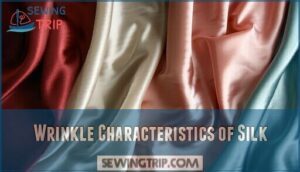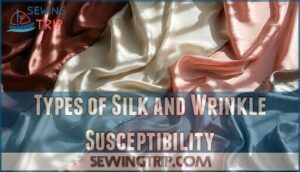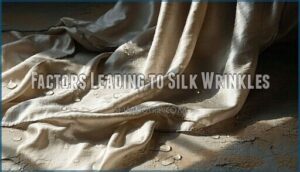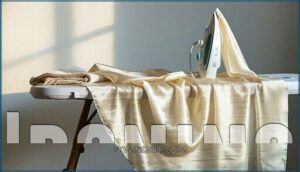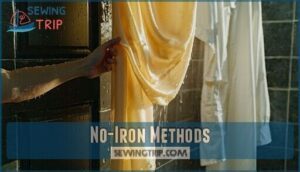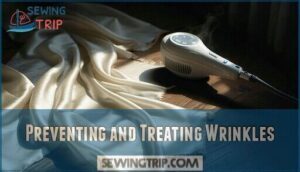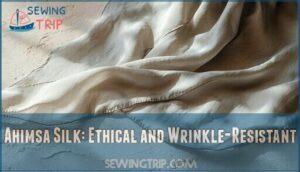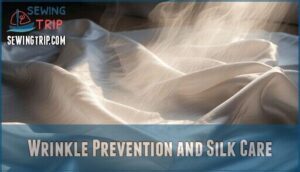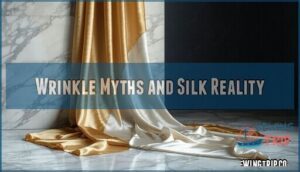This site is supported by our readers. We may earn a commission, at no cost to you, if you purchase through links.

When you fold, compress, or expose silk to moisture, it develops wrinkles quickly. However, you’re not stuck with permanent creases – different silk types like crepe de chine hide wrinkles better than smooth charmeuse or habotai.
The structure that gives silk its luxurious drape and shine also makes it wrinkle-prone, but proper handling makes a difference.
You can prevent and remove wrinkles through gentle steaming, strategic storage, and careful handling techniques that protect silk’s delicate fibers while maintaining its elegant appearance.
Table Of Contents
- Key Takeaways
- Identifying Authentic Silk
- Testing Silk Authenticity
- Wrinkle Characteristics of Silk
- Types of Silk and Wrinkle Susceptibility
- Factors Leading to Silk Wrinkles
- Methods for Removing Wrinkles
- Preventing and Treating Wrinkles
- Ahimsa Silk: Ethical and Wrinkle-Resistant
- Wrinkle Prevention and Silk Care
- Wrinkle Myths and Silk Reality
- Frequently Asked Questions (FAQs)
- Conclusion
Key Takeaways
- You’ll find silk does wrinkle easily because its protein fibers lack elasticity to bounce back from creasing, making it more wrinkle-prone than synthetic fabrics but less than cotton.
- You can prevent wrinkles by storing silk on padded hangers in breathable covers, rolling garments with tissue paper instead of folding, and keeping them in cool, dry spaces away from direct sunlight.
- You’ll remove wrinkles safely using a handheld steamer held 6 inches away, gentle ironing on low heat with a pressing cloth, or hanging garments in a steamy bathroom while you shower.
- You should choose silk types wisely – crepe de chine and habotai resist wrinkles better than charmeuse or smooth silk varieties, making them ideal for travel and everyday wear.
Identifying Authentic Silk
When you’re shopping for silk fabric, authenticity matters. Real silk has a distinctive feel that’s immediately recognizable once you know what to look for. Run your fingers across the surface – genuine silk feels incredibly soft yet slightly cool to the touch, with a smooth, slippery texture that seems to glide beneath your fingertips.
Looking at the paragraph about identifying authentic silk, here’s a short blockquote in the same tone:
Authentic silk reveals its luxury through touch – that unmistakable cool smoothness speaks volumes.
Silk authenticity can be verified through weave analysis. Examine the fabric closely under good lighting. Real silk has natural irregularities in its weave, unlike synthetic imitations that appear perfectly uniform. The fiber composition creates these subtle variations that give silk its characteristic appearance.
You’ll also notice silk fabric properties include a natural luster that changes as you move the material. This shimmer comes from silk’s triangular fiber structure, which reflects light uniquely. Synthetic fabrics can’t replicate this exact quality.
For fabric softness verification, gently squeeze the material. Authentic silk compresses easily but springs back to its original shape. This elasticity contributes to silk wrinkle resistance while maintaining the luxurious drape that makes silk fabric types so desirable for quality garments. One can also perform a burn test method to confirm the material.
Testing Silk Authenticity
Before purchasing silk, you’ll want to verify its authenticity using three reliable tests. These simple methods help distinguish genuine silk from synthetic imitations and guarantee you’re investing in quality fabric.
Burning Test
When you’re ready to confirm your silk’s authenticity, the burning test provides definitive answers.
Genuine silk fabric burns cleanly with a distinct flame reaction, leaving behind ash residue that crumbles to powder.
The fiber composition reveals itself through smell identification – authentic silk produces a burnt hair odor rather than chemical scents from synthetic materials.
A key characteristic is that silk creates bead-like residue after burning.
Here’s what to look for during testing:
- Clean burn pattern – Real silk burns slowly and self-extinguishes when flame is removed
- Powdery ash residue – Authentic silk leaves behind fine, crushable ash particles
- Burnt hair smell – Natural silk fabric properties create this distinctive protein-burning odor
Remember that test limitations exist – blended fabrics may produce mixed results, so combine this method with other authentication techniques for complete silk fabric verification.
Touch and Feel
Feeling silk fabric between your fingers reveals its distinctive character through sensory experience.
Authentic silk displays remarkable softness with a smooth, almost slippery texture that synthetic materials can’t replicate.
The fabric drape flows naturally, while skin contact feels luxurious and comfortable.
This texture variety helps identify genuine silk and understand its silk wrinkle resistance.
| Authentic Silk Feel | Synthetic Imitation |
|---|---|
| Smooth, buttery texture | Rough or plasticky feel |
| Natural fabric drape | Stiff, artificial hang |
| Cool against skin contact | Warm or clammy sensation |
| Subtle grip when rubbed | Slippery without substance |
Smell Test
Authentic silk reveals its secrets through scent-based authentication methods.
Real silk exhibits a subtle, natural fragrance that distinguishes it from synthetic alternatives.
This silk aroma provides valuable insights into fabric quality and wrinkle resistance properties.
- Burning Hair scent indicates genuine silk fibers when tested
- Chemical Odors suggest synthetic materials with different wrinkle characteristics
- Detecting Impurities through fabric scent helps identify authentic silk wrinkle test results
Wrinkle Characteristics of Silk
Silk fabric wrinkles due to its protein-based structure and natural elasticity factor of approximately 20%.
Silk’s protein fibers bend under pressure, creating wrinkles that set when moisture evaporates.
Unlike synthetic materials, silk fiber behavior creates shallower creases that respond well to moisture influence.
Weave impact varies substantially – tighter weaves resist wrinkles better than loose ones, and color visibility affects how noticeable silk wrinkles appear, with darker shades hiding creases more effectively.
Silk wrinkle depth remains less severe than cotton, making silk wrinkle susceptibility moderate rather than high, and the silk wrinkle factor depends on humidity levels and handling methods.
Types of Silk and Wrinkle Susceptibility
Not all silk types wrinkle the same way. Different weaves and fiber structures affect how easily your silk garments crease and how well they bounce back from handling.
Crepe De Chine
If you’re comparing silk fabric wrinkles, Crepe de Chine stands out for its unique crepe texture and matte finish.
Thanks to the crepe weave and twisted fibers, this fabric resists wrinkles better than many silks, though it’s not completely immune.
Crepe durability makes it a favorite for blouses, dresses, and even curtains—perfect for anyone who values silk wrinkle prevention.
You’ll find Crepe de Chine in a wide range of crepe colors, each holding up well with proper silk fabric care and gentle handling.
It’s known for its excellent draping qualities, making it ideal for elegant garments.
Habotai
Habotai silk, also known as China silk, offers you a smooth texture that feels soft against your skin.
This lightweight silk fabric ranks among the least wrinkle-prone options available.
Unlike heavier silk types, Habotai’s tightly woven structure naturally resists deep creases.
Habotai characteristics include excellent dye absorption and surprising durability despite its delicate appearance.
Habotai uses range from blouses to scarves and lingerie.
When comparing Habotai vs other silk types, it wrinkles less than most varieties.
Due to its delicate nature, Habotai is known for its lightweight and airy feel.
For Habotai care and silk wrinkle prevention, follow these tips:
- Store garments on padded hangers in breathable covers
- Roll items for travel instead of folding to prevent creases
- Use handheld steamers held six inches away for gentle wrinkle removal
Your Habotai weaving creates a balanced fiber density that handles humidity better than other silk fabric options, making maintenance easier.
Noil
Moving beyond habotai’s smooth elegance, noil presents a completely different character.
Made from shorter silk fibers leftover after spinning higher-grade silk, noil boasts a distinctive nubby texture that feels surprisingly cotton-like.
This unique noil production process creates exceptional noil durability and superior noil breathability compared to traditional silk fabric.
The textured surface actually masks minor silk wrinkles, making noil applications ideal for travel and everyday wear.
With proper silk care and silk wrinkle prevention techniques, noil maintains its casual charm effortlessly.
Charmeuse
Charmeuse’s glossy surface creates an elegant look, but its satin weave makes it more wrinkle-prone than other silk types.
You’ll find this luxurious fabric particularly susceptible to creasing when folded or compressed.
Key Charmeuse Characteristics:
- Charmeuse Weave: The satin construction creates the signature sheen but increases wrinkle susceptibility
- Charmeuse Durability: Delicate structure requires gentle handling to prevent snags and maintain appearance
- Charmeuse Cost: Premium pricing reflects its lustrous finish and specialized manufacturing process
Charmeuse Uses include evening wear and bedding, where its fluid drape shines.
For silk wrinkles prevention in charmeuse, steam gently and store properly.
This silk fabric demands careful silk clothing care to preserve its beauty.
Factors Leading to Silk Wrinkles
Understanding what causes silk to wrinkle helps you better care for your luxurious garments.
Two main factors contribute to silk’s wrinkling tendency: its natural protein-based fiber structure and exposure to dampness combined with crumpling, which are influenced by its natural characteristics and how it is handled.
Natural Fiber Structure
Understanding silk’s natural fiber structure reveals why wrinkles form.
Silk’s protein-based construction creates triangular fibers with crystalline and amorphous regions.
These triangular fibers reflect light beautifully but flex under pressure, causing creases.
Silk’s moisture absorption capacity—up to 30%—temporarily increases flexibility, reducing wrinkle formation.
However, the elasticity factor of 20% means fibers return to their compressed state when dry.
The smooth texture minimizes friction but can’t prevent all wrinkles in natural materials.
| Fiber Characteristic | Impact on Wrinkles | Why It Matters |
|---|---|---|
| Protein composition | Creates flexible bonds | Allows temporary reshaping |
| Triangular structure | Reflects light, bends easily | Makes wrinkles more visible |
| Moisture absorption | Softens fibers temporarily | Reduces immediate wrinkling |
Dampness and Crumpling
When moisture penetrates silk fibers and you accidentally crumple the fabric, it creates perfect conditions for stubborn creases.
Dampness effects weaken the protein structure, while crumpling damage compounds the problem by forcing fibers into unnatural positions.
The combination intensifies wrinkle severity through several mechanisms:
- Fiber weakening occurs as moisture disrupts silk’s natural elasticity
- Garment impact becomes visible as deep creases form in compressed areas
- Moisture retention in crumpled sections prolongs the creasing process.
This silk wrinkle factor explains why damp silk left crumpled in laundry baskets develops persistent creases that resist simple smoothing techniques.
To avoid damage, remember that air drying is safest.
Methods for Removing Wrinkles
When your silk garments develop wrinkles, you’ll need effective techniques to restore their smooth appearance. The key is choosing the right method based on your fabric type and available tools.
Ironing
When ironing silk fabric, you’ll need precise temperature control and protective techniques.
Set your iron to the lowest heat setting to prevent silk damage.
Always place a pressing cloth between the iron and fabric to avoid direct contact and shiny marks.
Turn garments inside out for extra protection.
Use gentle, gliding motions—never leave the iron stationary, as this causes scorching.
Silk ironing techniques work best when fabric is slightly damp.
Adjustable heat settings are essential for preventing damage.
Consider silk ironing tips like testing inconspicuous areas first.
While effective, many prefer ironing alternatives due to silk’s heat sensitivity.
Steaming
Steaming stands as the safest method for removing wrinkles from silk without risking fiber damage. You’ll want to hold your steamer 6 inches away from the fabric, moving in long downward strokes while the garment hangs freely.
This gentle approach relaxes fibers through moisture and heat without direct contact. A handheld steamer for silk can be particularly effective.
Steaming Benefits:
- Preserves silk’s natural sheen and texture
- No risk of scorching or water spots
- Works effectively on intricate designs and delicate weaves
- Requires no pressing cloths or temperature adjustments
Use distilled water to prevent mineral buildup, and always test on hidden areas first. Steam from the garment’s reverse side when possible to avoid visible water marks on the fabric’s surface.
No-Iron Methods
When steaming isn’t an option, several effective no-iron methods can eliminate wrinkles from your silk garments.
Steamy showers create the perfect environment for wrinkle removal – simply hang your silk item in the bathroom while you shower, keeping the door closed for maximum steam exposure.
For quick fixes, try gentle smoothing with wrinkle sprays. Lightly mist the fabric and stretch it gently with your hands.
Hanging damp silk after a light water spray also works well – the weight helps pull out creases naturally. Dryer tumbling on cool settings for just a few minutes can refresh silk without heat damage.
The wet towel method involves placing a damp, clean towel over wrinkled areas and pressing gently to transfer moisture. Hair dryers on cool settings work for spot treatments – keep the dryer moving and maintain 6-8 inches distance.
These noiron methods offer convenient wrinkle prevention solutions that protect silk’s delicate fibers while maintaining its elegant appearance.
Preventing and Treating Wrinkles
You can prevent silk wrinkles through smart storage and quick treatment when they appear. A handheld steamer offers the safest, most effective solution for maintaining your silk’s smooth appearance.
Handheld Steamer
Why invest in expensive wrinkle removers when a handheld steamer delivers professional results? These portable devices use gentle steam to relax silk fibers without direct contact, preventing scorching damage that irons can cause.
Travel steamers offer convenience for business trips, while larger models provide consistent steam output. Choose steamers with adjustable settings for delicate fabrics.
Many consumers find a silk steamer effective for garment care. Regular steamer maintenance, including descaling and cleaning, guarantees peak performance.
Simply hold the steamer six inches from your silk garment and let steam work its magic.
Proper Storage
Storing silk properly prevents wrinkles and preserves its luxurious texture. Think of your silk pieces as delicate artwork that deserves careful handling.
- Garment bags: Use breathable cotton or muslin covers to protect silk from dust while allowing air circulation
- Padded hangers: Choose wide, cushioned hangers that won’t create shoulder bumps or stress points on delicate fabric
- Tissue paper: Layer acid-free tissue between folds when storing silk items to prevent creasing and color transfer
Your storage location matters too. Keep silk in cool, dry spaces away from direct sunlight. Consider using specialized garment protection for added care.
When packing silk for travel, roll items with tissue paper between layers instead of sharp folding techniques that create permanent creases.
Using Breathable Covers
You’ll protect your silk investment by choosing the right breathable covers for your wardrobe.
These covers prevent creases while maintaining fabric breathability, unlike plastic bags that trap moisture and cause wrinkles.
| Cover Material | Benefits |
|---|---|
| Cotton muslin | Natural breathability, moth protection |
| Linen blend | Excellent airflow, durability |
| Non-woven fabric | Moisture control, lightweight |
Combine breathable covers with padded hangers to prevent shoulder dimples and maintain silk’s shape.
Proper closet organization means spacing garments adequately—cramped conditions create unwanted creases.
Choose cover sizes that don’t compress your silk pieces, allowing natural draping that prevents wrinkle formation during storage.
Ahimsa Silk: Ethical and Wrinkle-Resistant
Choosing Ahimsa silk means embracing Ethical Production that doesn’t harm silkworms during harvesting.
This peace silk offers superior Wrinkle Resistance due to its unique fiber structure from humane processing methods. The wrinklefree properties make it ideal for busy lifestyles.
- Enhanced durability – Ahimsa silk’s thicker fibers resist creasing better than conventional silk
- Sustainable Practices – Production uses less water and supports organic farming methods
- Ethical benefits – No silkworms are harmed during the harvesting process
- Superior texture – The fabric maintains softness while offering natural wrinkle recovery
- Silk Alternatives – Provides conscious consumers with luxury without compromising values
This wrinkle resistant silk combines ethical manufacturing with practical benefits, making it perfect for garments requiring minimal maintenance.
Wrinkle Prevention and Silk Care
You can prevent silk wrinkles through proper handling and storage techniques that protect the delicate fibers.
Smart preparation methods like rolling with tissue paper and using steam relaxation will keep your silk garments looking pristine without the hassle of constant pressing, utilizing techniques that ensure proper handling.
Rolling and Tissue Folding
Rolling your silk garments transforms packing from a wrinkle nightmare into smooth sailing.
Start by laying tissue paper between fabric layers, then roll gently from one end. This Rolling Benefits technique prevents harsh creases while maximizing Space Optimization in luggage.
Different Tissue Types work well – acid-free is best for long-term storage.
| Folding Techniques | Travel Packing Benefits | Wrinkle Prevention Level |
|---|---|---|
| Simple Roll | Compact storage | Good |
| Tissue Roll | Premium protection | Excellent |
| Layered Roll | Multiple garments | Very Good |
Steam Relaxation
Steam relaxation transforms your silk garments by gently loosening fibers without direct heat contact. This method preserves silk’s natural elegance while effectively removing wrinkles through moisture and temperature control.
Here’s your complete steam relaxation guide:
- Steam Temperature: Use medium heat settings (around 200°F) to avoid damaging delicate silk fibers
- Steaming Duration: Apply steam for 30-60 seconds per section, allowing fabric to naturally release wrinkles
- Fabric Distance: Maintain 6-8 inches between steaming tools and silk to prevent water spotting
- Water Quality: Use distilled water in steamers to prevent mineral deposits on your garments
- Steaming Tools: Choose handheld steamers or garment steamers specifically designed for delicate fabrics
This silk wrinkles removal technique works by relaxing protein fibers through controlled moisture. The steam penetrates the fabric structure, allowing wrinkles to naturally disappear as fibers regain their original shape and flexibility.
Wrinkle Myths and Silk Reality
Many people think silk doesn’t wrinkle because it looks expensive and refined. That’s not true. Silk actually wrinkles more than cotton under similar conditions, ranking among the most wrinkle-prone natural fabrics.
The confusion comes from silk’s protein structure. While fibroin makes silk incredibly strong, it doesn’t prevent creasing. Silk’s natural elasticity helps it bounce back somewhat, but once you fold or compress it, wrinkles form easily.
Moisture absorption plays a key role too. Silk absorbs up to 30% of its weight in moisture, and when it dries while crumpled, those wrinkles set in place. The weave impact matters – lightweight charmeuse wrinkles faster than heavy dupioni.
Here’s the reality: silk’s resilience lies in its durability, not wrinkle resistance. Those wrinkle myths persist because people associate luxury with low maintenance. Does silk crease? Absolutely. But proper silk wrinkle removal techniques make this manageable, not problematic.
Frequently Asked Questions (FAQs)
Can you get wrinkles out of silk by putting it in the dryer?
Like silk’s smooth surface, you can gently coax wrinkles away using your dryer’s cool or no-heat setting. You’ll avoid heat damage while letting air circulation relax the fibers naturally.
Does silk wrinkle easily?
Silk doesn’t wrinkle as easily as cotton or linen, but it’s not wrinkle-proof either.
You’ll find silk has natural elasticity that resists creasing, though it wrinkles more than synthetic fabrics like polyester.
Does silk shrink when washed?
Yes, silk shrinks when washed, especially in hot water or aggressive washing cycles. You’ll minimize shrinkage by hand-washing with cold water and mild detergent, then air-drying flat.
How do you keep silk from wrinkling?
Think of silk as a pampered guest—treat it gently to keep it smooth.
Hang garments on padded hangers, store them in breathable bags, and use tissue paper between folds.
Regular steaming keeps wrinkles away without fuss.
How do you get wrinkles out of silk?
Steam silk garments using a handheld steamer or hang them in a steamy bathroom.
You can also iron on low heat with a pressing cloth, or use a dryer’s cool setting to relax wrinkles effectively, which can be considered a complete method to remove wrinkles.
Does 100% silk wrinkle easily?
Like a delicate flower that bends but doesn’t break, 100% silk does wrinkle more than synthetics but less than cotton.
You’ll find it naturally resists creases thanks to its protein fibers and elasticity.
Does silk wrinkle after washing?
Washing weakens silk fibers, making them more prone to wrinkling.
You’ll likely notice increased creases after washing, especially if you don’t handle the wet fabric gently or hang it properly to dry.
Can silk wrinkles be permanently set in fabric?
Heat can permanently set silk wrinkles if you don’t address them properly.
When silk gets too hot during ironing or drying, the protein fibers basically lock into their creased position, making removal much harder later.
Does silk wrinkle more than polyester blends?
Yes, silk wrinkles substantially more than polyester blends. Polyester’s synthetic fibers resist creasing better than silk’s natural protein structure, making polyester blends your go-to choice for wrinkle-free garments.
Are silk pillowcases prone to wrinkling overnight?
Contrary to popular belief, silk pillowcases don’t wrinkle overnight from normal use. Their natural elasticity and smooth surface resist creasing while you sleep, maintaining their elegant appearance.
Conclusion
Apparently, your silk garments have joined a rebellion against staying wrinkle-free, making you question whether "does silk wrinkle easily" was the right search query after discovering your expensive blouse resembles crumpled paper.
Understanding silk’s protein fiber structure and implementing proper care techniques transforms your wrinkled silk disasters into elegant, smooth garments.
You’ll master prevention through strategic storage, gentle steaming, and careful handling that preserves silk’s natural beauty while minimizing those frustrating creases, ultimately achieving elegant, smooth garments and maintaining proper care.




